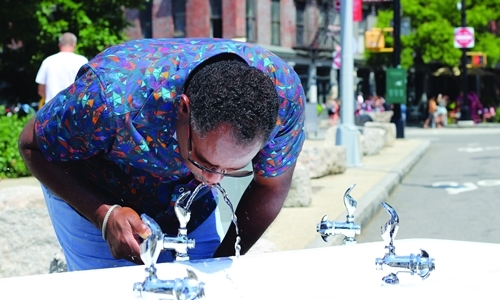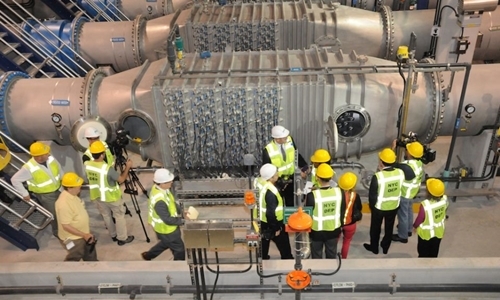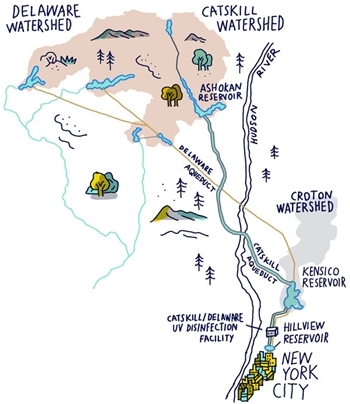Americans New Yorkers like to brag about their drinking water because it's safe and dubbed the "champagne of water".
The New York Public Benefit Research Group reported this year that New York City is home to the cleanest water in the state. New York is also among the best water quality urban areas in the US. New Yorkers often say that they make delicious pizzas and bagels famous for their "secret ingredient" of clean water.

A man drinks water from a public tap in New York Photo: NYC Water
New York's drinking water starts from three major basins - the Delaware and Catskill system west of the Hudson River and the Croton system north of the city. These river basins are low in limestone and have a natural pH of 7.2, close to the pH 7 of pure water. In 2017, New York used about 97% of the water from Catskill / Delaware and about 3% from the Croton system.
These basins provide water for more than a dozen reservoirs. The largest reservoir, Pepacton, has a capacity of 140 billion gallons (530 million m3). The Ashokan in Ulster County has a capacity of 123 billion gallons (465 million m3).
Officials measure the index throughout the reservoirs, looking at things like water turbidity / transparency and pollutants, to choose the highest quality water to release to the downline. Water supply is so important to the city that a dedicated police force of more than 200 members works 24/7 to prevent illegal littering and other misuse of waterways.
Next, the water flows from the reservoirs through a series of sewers and tunnels, including the Catskill sewer built 100 years ago, extending nearly 150 km from the Ashokan reservoir in the Catskill mountain range to the northern boundary. of the city. When it was completed in the early 1900s, the Catskill drain was considered by some to be a work of engineering at the level of the Panama or Suez Canal.

New York water disinfection system Photo: DEP
The Delaware 136 km long was completed in the mid-1940s. Delaware was so large that a two-person submarine was used to check for leaks there.
The water then arrives at Kensico Reservoir nearly 5 km north of the White Plains in Westchester. Here, the water is treated with fluoride and disinfected at what is considered the world's largest UV treatment facility. Ultraviolet treatment is especially useful in killing Cryptosporidium and Giardia, harmful microorganisms.
Water continues to have another stop is the Hillview reservoir at Yonkers. This reservoir aims to balance daily needs (water consumption of the people goes up in the morning and in the evening when people are at home). Water also continues to be disinfected here.
From the sluices, water is distributed throughout the city through three tunnels - the first was put into use in 1917, the second was put into use in 1936. Tunnel 3 began serving the area. Bronx and upper Manhattan since 1998 and expanded in 2013. The water then came to the main pipes and residential faucets.

New York water supply system Photo: NYTimes
New York water supply system. Graphics: NYTimes.
Every day, dozens of scientists monitor the quality of New York's domestic water, collect samples and test it no less than 600,000 times a year to make sure there are no pollutants. They also have an army of surveillance robots at the reservoirs, testing 1.6 million more quality tests per year. The New York Department of Environmental Protection produces water quality reports every year.
New York is one of the few cities in the US that is allowed to supply nearly all tap water without having to rely on expensive refineries. "The water system may be the city's most important asset, or at least on par with the metro system," said Eric A. Goldstein, senior attorney at the Natural Resources Protection Council, talk. "Imagine living without clean water in New York for even one day. Life will be stagnant."



 StacyDSmith
StacyDSmith







